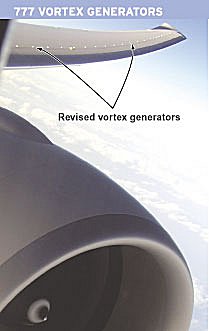 Boeing 777-300ER operators have begun ordering modification kits to reduce drag and improve performance following delivery of the first aircraft equipped with the features as standard to Air France.
Boeing 777-300ER operators have begun ordering modification kits to reduce drag and improve performance following delivery of the first aircraft equipped with the features as standard to Air France.
The French carrier is also thought to be ordering the bulk of the upgrade kits as it already operates 11 of the 27 -300ERs currently in service. Others studying or actively ordering the upgrade include All Nippon Airways, EVA Air, Emirates and Japan Airlines. The kit, which improves fuel efficiency by 1.4%, is covered by a service bulletin and includes revised vortex generators (VG) and changes to the ram-air system duct exit, and is sufficient to save the equivalent of almost 760,000 litres (200,000USgal) of fuel a year.
Added to earlier engine enhancements, and better-than-expected fuel mileage performance from flight tests and initial production aircraft, the kit means the 777-300ER fuel consumption is around 3.5% better than originally predicted at the start of the development effort in 2003. Each 1% saving is equal to approximately 140km (75nm) extra range, or an extra 10 passengers or 1,090kg (2,400lb) of cargo. “This means these customers will either use the improvement to fly further or, if they are passenger limited, take more passengers,” says 777 derivatives engineering leader Dennis Todd.
The additional series of seven outboard vortex generators were originally added to improve handling with the raked wing tip, but “had a surprising fuel burn benefit of around eight-tenths of a percent”, says Todd. The modification kit also includes smaller VGs, similar to those on 737s, to replace the existing inboard devices.
Modifications to the ram-air system exhaust duct involve retrofitting louvres that are programmed to work in conjunction with the ram-air inlet duct. “Depending on the setting we found we got a fairly high pressure delta, which caused a significant increase in drag. So by modulating these louvres in various phases of flight we have significantly reduced the pressure loss and the drag. We were able to get about four-tenths of a percent drag improvement,” says Todd. The louvres are controlled by revised software in the cabin pressure system, and are being studied as one of the easier retrofit items for a wider 777-200ER “enhanced” upgrade.
Boeing also confirms that the overall performance improvements seen during flight testing and early operational experience with the -300ER have been verified on the -200LR. Final certification paperwork is now being processed on the -200LR, which is capable of maximum ranges up to 17,450km with a full payload of 301 passengers and three auxiliary belly fuel tanks. First delivery to Pakistan International Airlines is now expected in February, one month later than originally scheduled due to the effects of the Boeing machinists strike earlier this year.
GUY NORRIS/LOS ANGELES
Source: Flight International























